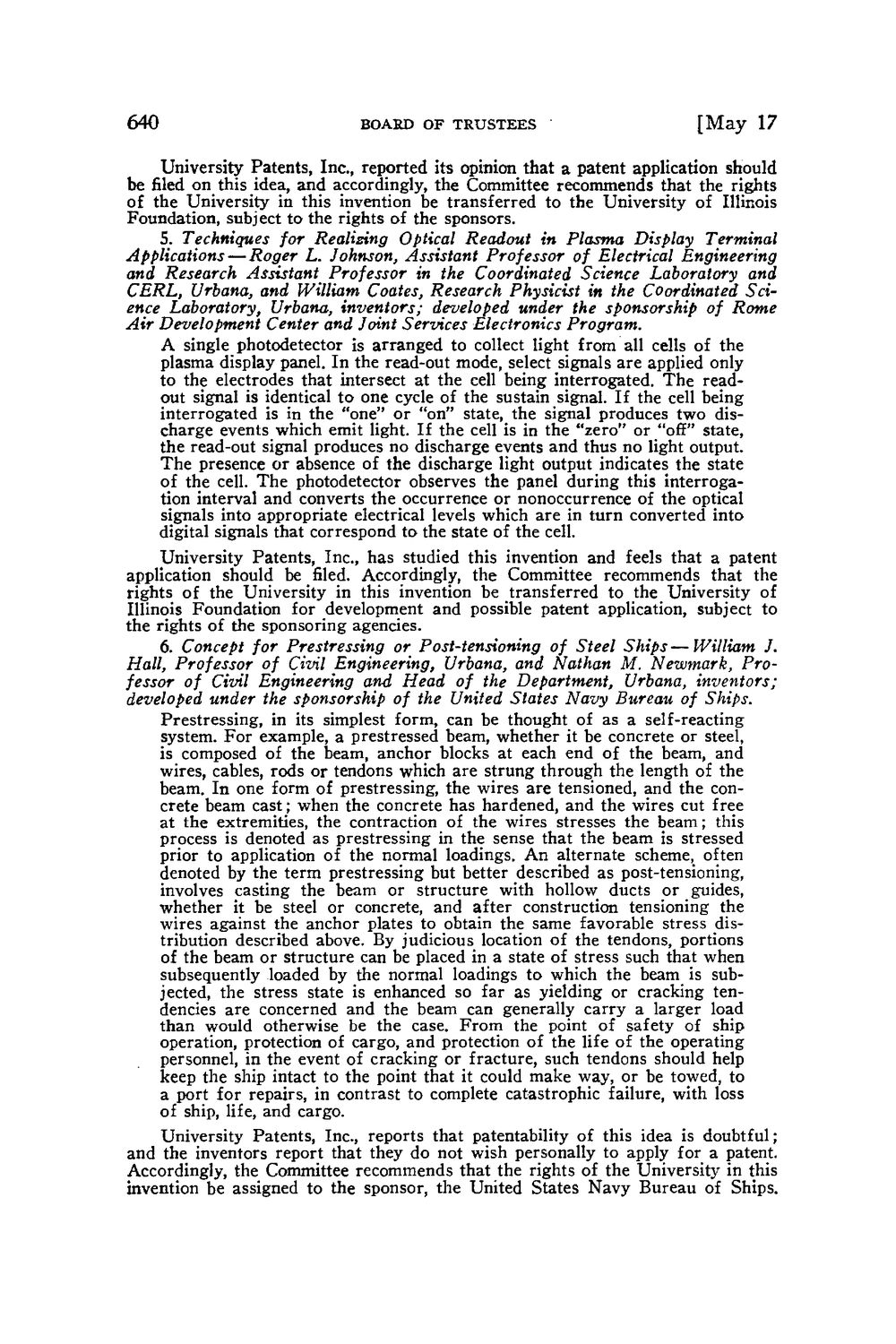| |
| |
Caption: Board of Trustees Minutes - 1972
This is a reduced-resolution page image for fast online browsing.

EXTRACTED TEXT FROM PAGE:
640 BOARD OF TRUSTEES [May 17 University Patents, Inc., reported its opinion that a patent application should be filed on this idea, and accordingly, the Committee recommends that the rights of the University in this invention be transferred to the University of Illinois Foundation, subject to the rights of the sponsors. 5. Techniques for Realizing Optical Readout in Plasma Display Terminal Applications — Roger L. Johnson, Assistant Professor of Electrical Engineering and Research Assistant Professor in the Coordinated Science Laboratory and CERL, Urbana, and William Coates, Research Physicist in the Coordinated Science Laboratory, Urbana, inventors; developed under the sponsorship of Rome Air Development Center and Joint Services Electronics Program. A single photodetector is arranged to collect light from all cells of the plasma display panel. In the read-out mode, select signals are applied only to the electrodes that intersect at the cell being interrogated. T h e readout signal is identical t o one cycle of the sustain signal. If the cell being interrogated is in the "one" or "on" state, the signal produces two discharge events which emit light. If the cell is in the "zero" or "off" state, the read-out signal produces no discharge events and thus no light output. T h e presence or absence of the discharge light output indicates the state of the cell. T h e photodetector observes the panel during this interrogation interval and converts the occurrence or nonoccurrence of the optical signals into appropriate electrical levels which are in turn converted into digital signals that correspond to the state of the cell. University Patents, Inc., has studied this invention and feels that a patent application should be filed. Accordingly, the Committee recommends that the rights of the University in this invention be transferred to the University of Illinois Foundation for development and possible patent application, subject to the rights of the sponsoring agencies. 6. Concept for Prestressing or Post-tensioning of Steel Ships — William J. Hall, Professor of Civil Engineering, Urbana, and Nathan M. Newmark, Professor of Civil Engineering and Head of the Department, Urbana, inventors; developed under the sponsorship of the United States Navy Bureau of Ships. Prestressing, in its simplest form, can be thought of as a self-reacting system. For example, a prestressed beam, whether it be concrete or steel, is composed of the beam, anchor blocks at each end of the beam, and wires, cables, rods or tendons which are strung through the length of the beam. In one form of prestressing, the wires are tensioned, and the concrete beam cast; when the concrete has hardened, and the wires cut free at the extremities, the contraction of the wires stresses the beam; this process is denoted as prestressing in the sense that the beam is stressed prior to application of the normal loadings. An alternate scheme, often denoted by the term prestressing but better described as post-tensioning, involves casting the beam or structure with hollow ducts or guides, whether it be steel or concrete, and after construction tensioning the wires against the anchor plates to obtain the same favorable stress distribution described above. By judicious location of the tendons, portions of the beam or structure can be placed in a state of stress such that when subsequently loaded by the normal loadings to which the beam is subjected, the stress state is enhanced so far as yielding or cracking tendencies are concerned and the beam can generally carry a larger load than would otherwise be the case. F r o m the point of safety of ship operation, protection of cargo, and protection of the life of the operating personnel, in the event of cracking or fracture, such tendons should help keep the ship intact to the point that it could make way, or be towed, to a port for repairs, in contrast to complete catastrophic failure, with loss of ship, life, and cargo. University Patents, Inc., reports that patentability of this idea is doubtful; and the inventors report that they do not wish personally to apply for a patent. Accordingly, the Committee recommends that the rights of the University in this invention be assigned to the sponsor, the United States Navy Bureau of Ships.
| |